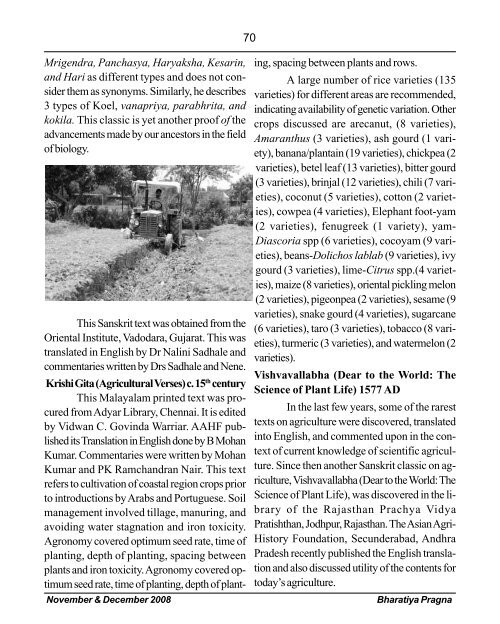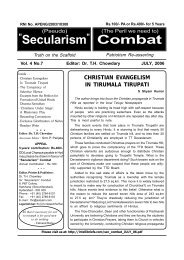Bharatiya Pragna - Dr. Th Chowdary
Bharatiya Pragna - Dr. Th Chowdary
Bharatiya Pragna - Dr. Th Chowdary
You also want an ePaper? Increase the reach of your titles
YUMPU automatically turns print PDFs into web optimized ePapers that Google loves.
Mrigendra, Panchasya, Haryaksha, Kesarin,<br />
and Hari as different types and does not consider<br />
them as synonyms. Similarly, he describes<br />
3 types of Koel, vanapriya, parabhrita, and<br />
kokila. <strong>Th</strong>is classic is yet another proof of the<br />
advancements made by our ancestors in the field<br />
of biology.<br />
<strong>Th</strong>is Sanskrit text was obtained from the<br />
Oriental Institute, Vadodara, Gujarat. <strong>Th</strong>is was<br />
translated in English by <strong>Dr</strong> Nalini Sadhale and<br />
commentaries written by <strong>Dr</strong>s Sadhale and Nene.<br />
Krishi Gita (Agricultural Verses) c. 15 th century<br />
<strong>Th</strong>is Malayalam printed text was procured<br />
from Adyar Library, Chennai. It is edited<br />
by Vidwan C. Govinda Warriar. AAHF published<br />
its Translation in English done by B Mohan<br />
Kumar. Commentaries were written by Mohan<br />
Kumar and PK Ramchandran Nair. <strong>Th</strong>is text<br />
refers to cultivation of coastal region crops prior<br />
to introductions by Arabs and Portuguese. Soil<br />
management involved tillage, manuring, and<br />
avoiding water stagnation and iron toxicity.<br />
Agronomy covered optimum seed rate, time of<br />
planting, depth of planting, spacing between<br />
plants and iron toxicity. Agronomy covered optimum<br />
seed rate, time of planting, depth of plant-<br />
70<br />
ing, spacing between plants and rows.<br />
A large number of rice varieties (135<br />
varieties) for different areas are recommended,<br />
indicating availability of genetic variation. Other<br />
crops discussed are arecanut, (8 varieties),<br />
Amaranthus (3 varieties), ash gourd (1 variety),<br />
banana/plantain (19 varieties), chickpea (2<br />
varieties), betel leaf (13 varieties), bitter gourd<br />
(3 varieties), brinjal (12 varieties), chili (7 varieties),<br />
coconut (5 varieties), cotton (2 varieties),<br />
cowpea (4 varieties), Elephant foot-yam<br />
(2 varieties), fenugreek (1 variety), yam-<br />
Diascoria spp (6 varieties), cocoyam (9 varieties),<br />
beans-Dolichos lablab (9 varieties), ivy<br />
gourd (3 varieties), lime-Citrus spp.(4 varieties),<br />
maize (8 varieties), oriental pickling melon<br />
(2 varieties), pigeonpea (2 varieties), sesame (9<br />
varieties), snake gourd (4 varieties), sugarcane<br />
(6 varieties), taro (3 varieties), tobacco (8 varieties),<br />
turmeric (3 varieties), and watermelon (2<br />
varieties).<br />
Vishvavallabha (Dear to the World: <strong>Th</strong>e<br />
Science of Plant Life) 1577 AD<br />
In the last few years, some of the rarest<br />
texts on agriculture were discovered, translated<br />
into English, and commented upon in the context<br />
of current knowledge of scientific agriculture.<br />
Since then another Sanskrit classic on agriculture,<br />
Vishvavallabha (Dear to the World: <strong>Th</strong>e<br />
Science of Plant Life), was discovered in the library<br />
of the Rajasthan Prachya Vidya<br />
Pratishthan, Jodhpur, Rajasthan. <strong>Th</strong>e Asian Agri-<br />
History Foundation, Secunderabad, Andhra<br />
Pradesh recently published the English translation<br />
and also discussed utility of the contents for<br />
today’s agriculture.<br />
November & December 2008 <strong>Bharatiya</strong> <strong>Pragna</strong>



